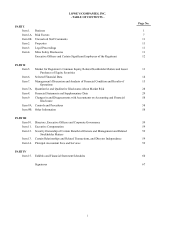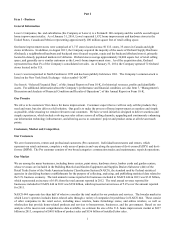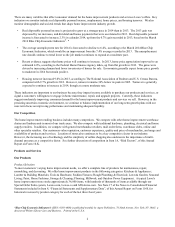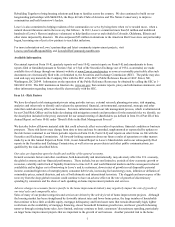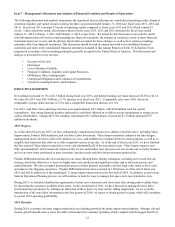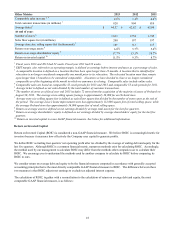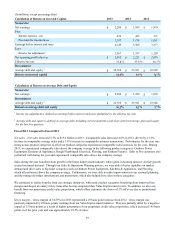Lowe's 2013 Annual Report Download - page 17
Download and view the complete annual report
Please find page 17 of the 2013 Lowe's annual report below. You can navigate through the pages in the report by either clicking on the pages listed below, or by using the keyword search tool below to find specific information within the annual report.9
If the domestic or international supply chain for our products is disrupted, our sales and gross margin would be adversely
impacted.
We source, stock, and sell products from over 7,000 domestic and international vendors and their ability to reliably and
efficiently fulfill our orders is critical to our business success. We source a large number of those products from foreign
manufacturers with China continuing to be the dominant import source. Financial instability among key vendors, political
instability or labor unrest in source countries, retaliatory trade restrictions imposed by either the United States or a major source
country, tariffs, currency exchange rates and transport capacity and costs are beyond our control and could negatively impact
our business if they seriously disrupted the movement of products through our supply chain or increased their costs.
Because of our operations in multiple countries, we must comply with multiple laws and regulations that differ substantially
from country to country.
If we fail to comply with these laws, rules and regulations, or the manner in which they are interpreted or applied, we may be
subject to government enforcement action, litigation, damage to our reputation, civil and criminal liability, damages, fines and
penalties, and increased cost of regulatory compliance, any of which could adversely affect our results of operations and
financial performance. These laws, rules and regulations include import and export requirements, U.S. laws such as the
Foreign Corrupt Practices Act, and local laws prohibiting corrupt payments to governmental officials. Although we have
implemented policies and procedures to help ensure compliance with these laws, there can be no assurance that our employees
and third parties with whom we do business will not take actions in violation of our policies or laws. We may also be subject to
investigations or audits by governmental authorities and regulatory agencies, which can occur in the ordinary course of
business or which can result from increased scrutiny from a particular agency towards an industry, country or practice.
If we are unable to secure or develop and implement sufficiently robust new technologies to deliver business process solutions
within the appropriate time frame, cost and functionality, our strategic initiatives that are dependent upon these technologies
may not be successful.
The success of our strategic initiatives designed to increase our sales and capture a greater percentage of our customers’
expenditures on home improvement projects is dependent in varying degrees on the timely delivery and the functionality of
information technology systems to support them. Extended delays or cost overruns in securing, developing and otherwise
implementing technology solutions to support the new business initiatives we are developing now, and will be developing in
the future, would delay and possibly even prevent us from realizing the projected benefits of those initiatives.
We may be unable to make the transformational changes we are undertaking in our business model.
We are adapting our business model to meet our customers’ changing expectations that we will not only sell them the products
and services they need and want, but also deliver better customer experiences. We will offer a cohesive group of products that
provide relevant occasion-based solutions and will present them in an inspiring manner. Our strategies require transformational
changes to our business model and will require new competencies in some positions, and our employees and independent
contractors, such as third-party installers and repair technicians, will not only have to understand non-traditional selling
platforms but also commit to fundamental changes in Lowe’s culture and the processes through which they have traditionally
interacted with customers. To the extent they are unable or unwilling to make these transformational changes, we may be
unable to operationalize our strategic initiatives, which are designed to increase our sales and capture a greater percentage of
our customers’ expenditures on home improvement projects. The many challenges our management faces as we adapt our
business model also increase the risk that we may not achieve our objectives.
If we fail to hire, train, manage and retain qualified sales associates and specialists with expanded skill sets who can work
effectively and collaboratively in an increasingly culturally diverse environment, we could lose sales to our competitors.
Our customers, whether they are homeowners or commercial businesses, expect our sales associates and specialists to be well
trained and knowledgeable about the products we sell and the home improvement services we provide. Increasingly, our sales
associates and specialists must have expanded skill sets, including, in some instances, the ability to do in-home or telephone
sales. In addition, in many of our stores our employees must be able to serve customers whose primary language and cultural
traditions are different from their own. A critical challenge we face is attracting and retaining a sufficiently diverse workforce
that can deliver a relevant, culturally competent and differentiated experience for a wide variety of culturally diverse customers.
Also, as our employees become increasingly culturally diverse, our managers and sales associates must be able to manage and
work collaboratively with employees whose primary language and cultural traditions are different from their own.



